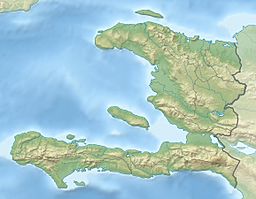Massif de la Hotte facts for kids
Quick facts for kids Massif de la Hotte |
|
|---|---|

Part of the Central Massif de la Hotte , the Tête Bœuf mountain chain seen from Bonnet Carre Haiti.
|
|
| Highest point | |
| Peak | Pic Macaya |
| Prominence | 2,097 m (6,880 ft) |
| Dimensions | |
| Length | 200 km (120 mi) |
| Geography | |
| Country | Haiti |
The Massif de la Hotte is a mountain range in southwestern Haiti. It is found on the Tiburon Peninsula. About 2.5 million years ago, the Massif de la Hotte was an island. It was separated from the Massif de la Selle by a wide sea channel. This isolation led to many unique species living there. These include special birds, plants, and reptiles. Many of them are found nowhere else on Earth.
The Massif de la Hotte has three parts. These are the Oriental la Hotte in the East, the Central la Hotte, and the Occidental la Hotte. The Occidental la Hotte is on the western tip of the Tiburon peninsula. It is quite remote. This area is one of the most diverse places for living things in all of Hispaniola. It also has some of Haiti's last dense cloud forests on its peaks.
Haiti has a World Heritage Site located in this region. After the 2010 Haiti earthquake, UNESCO helped Haiti check for damage.
Contents
Unique Life in the Massif de la Hotte
The Occidental la Hotte is the highest part of the Massif de la Hotte. It also has the most different kinds of plants and animals. Its highest point is Pic Macaya, which is about 2,347 meters (7,700 feet) tall. This is Haiti's second-highest peak. The changing heights in the Massif support many unique species. Many of these species are endemic, meaning they live only here.
Special Plants and Orchids
Many plants grow only in the Massif de la Hotte. Some examples include Magnolia ekmanii and Clavija domingensis. There are also many unique orchids. These include Lepanthes hotteana and Stelis glacensis. These plants and orchids are very important to the area's biodiversity.
Amazing Animals and Conservation
Conservation International says this region is one of the most important places in the world for conservation. It is home to 13 of Hispaniola's most critically endangered species. All of these are amphibians, like frogs. Two very rare frog species are Eleutherodactylus chlorophenax and Eleutherodactylus parapelates. These frogs live only in Haiti.
The Hispaniolan trogon, Haiti's national bird, also lives here. Many migrating birds, like Bicknell's thrushes, spend their winters in this area.
Protected Areas and Parks
The Massif de la Hotte has several important conservation areas. These include five national parks. They also have five habitat/species management areas. There are also two protected areas where people can use natural resources sustainably. The largest cave in the Caribbean islands, Grotte Marie Jeanne, is also here.
The national parks are:
- Pic Macaya National Park
- Grande Colline National Park
- Deux Mamelles National Park
- Grand Bois National Park
- Ile a Vache National Park
The habitat/species management areas include:
- Grosse Caye / Zone humide d'Aquin
- Olivier / Zanglais
- Pointe Abacou
- Fond de Cayes
- la Cahouane
The two protected areas for sustainable use are:
- Jeremie - Abricot
- Barcaderes Caymites
La Hotte Biosphere Reserve
The La Hotte Biosphere Reserve was created by UNESCO in 2016. A biosphere reserve is a special area recognized for its unique nature and how people live there. This reserve covers a very large area of land and sea. It has a core area where nature is strictly protected. It also has a buffer zone and a transition area. In these areas, people can live and use resources in a way that helps protect nature.
See also
 In Spanish: Macizo de la Hotte para niños
In Spanish: Macizo de la Hotte para niños
- Geography of Haiti
- Mountain ranges of the Caribbean
- World Conservation Monitoring Centre


